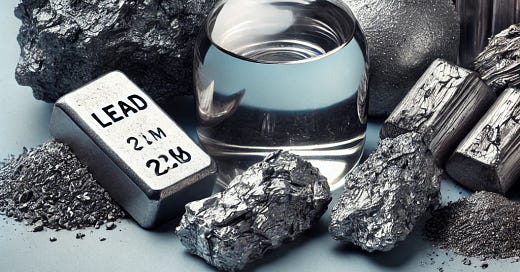Heavy Metals
TLDR - Heavy metals can enter our bodies and cause a danger response. This often requires detox support.
Expanded
Heavy metals are naturally occurring elements with high atomic weights and densities. Some are essential for biological functions in trace amounts, others are toxic and pose health risks even at low concentrations.
Lead: Commonly found in old paint, plumbing pipes, and contaminated soil. Lead can also be present in certain toys, cosmetics, and traditional medicines.
Mercury: Found in dental amalgam fillings, certain fish (like tuna and swordfish), and industrial emissions. It can also be present in some vaccines and thermometers.
Cadmium: Present in cigarette smoke, batteries, and some fertilizers. Cadmium can also be found in contaminated food and water.
Arsenic: Found in contaminated water, certain pesticides, and industrial processes. Arsenic can also be present in some rice and seafood.
How Heavy Metals Enter Our Bodies
Ingestion: Consuming contaminated food or water is a primary route. Foods like fish, rice, and leafy vegetables can accumulate heavy metals from polluted soil and water.
Inhalation: Breathing in polluted air, especially in industrial areas or from cigarette smoke, can introduce heavy metals into the lungs.
Skin Contact: Direct contact with contaminated soil, water, or products can allow heavy metals to be absorbed through the skin.
Impact on Body
Neurological Damage: Heavy metals like lead and mercury are particularly concerning due to their ability to cause neurological damage. This includes cognitive impairments, developmental delays in children, and increased risk of neurodegenerative diseases in adults.
Oxidative Stress and Mitochondrial Dysfunction: Heavy metals generate reactive oxygen species, leading to oxidative stress and mitochondrial dysfunction. This impairs cellular energy production and can lead to chronic fatigue, muscle weakness, and various metabolic disorders.
Immune System Impairment: Exposure to heavy metals can weaken the immune system, making individuals more susceptible to infections and autoimmune diseases. This is particularly true for metals like cadmium and arsenic.
Endocrine Disruption: Heavy metals can interfere with the endocrine system, disrupting hormone balance and leading to reproductive issues, thyroid dysfunction, and other hormonal imbalances.
Cardiovascular Risks: Long term exposure to heavy metals is linked to an increased risk of cardiovascular diseases, including hypertension, atherosclerosis, and heart disease.
Kidney Damage: Metals like cadmium and lead accumulate in the kidneys, causing renal dysfunction and increasing the risk of chronic kidney disease.
Detoxification Challenges: The body’s ability to detoxify heavy metals can be overwhelmed, especially with chronic exposure. This can lead to bioaccumulation and persistent health problems.
Detoxification Strategies
Reducing Exposure: Prioritize organic and locally sourced foods, avoid known sources of heavy metals like certain fish and contaminated water, and reduce the use of products containing these metals.
The Foundations: Support your body battery and your levers moving at the right time.
Clear Detoxification Pathways: Link to Clear Detox Pathways post.
Additional Detox Support: Supplements and protocols can be used to support the body’s detox pathways.



